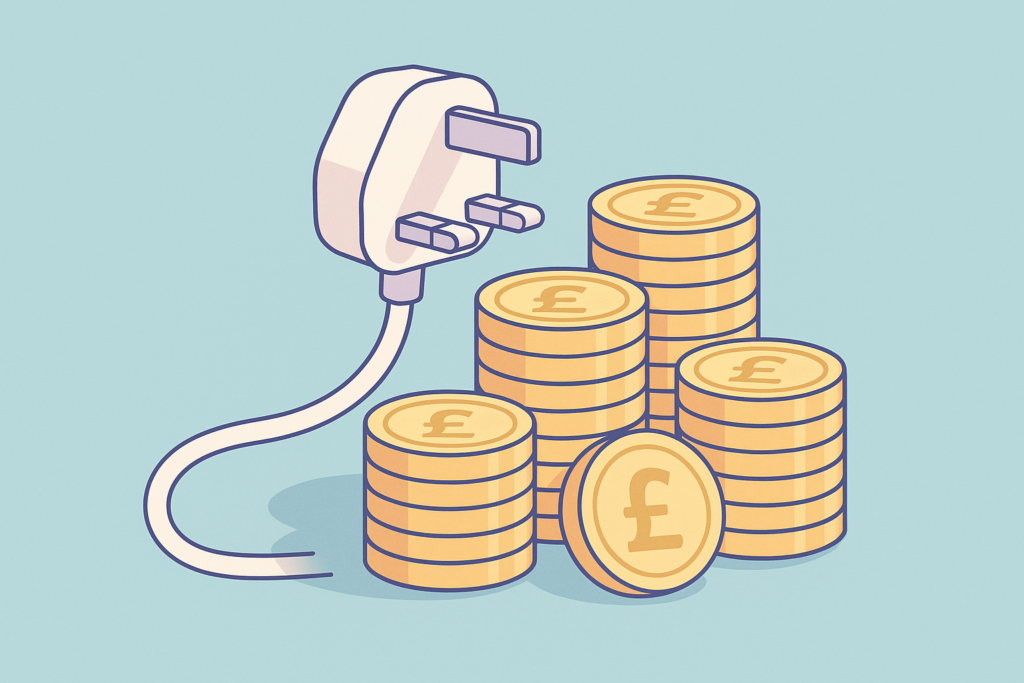UK electricity prices are among the highest in the world and most average households are feeling the strain. Even with more renewables on the grid than ever before, Britain’s electricity prices continue to rise.
In this post, we’ll break down the structural issues behind the UK’s costly power, from outdated pricing models to underfunded grid upgrades. How can reform, innovation, and offshore wind help flip the switch towards a cleaner, cheaper energy future?

Cheaper power won’t come from short-term fixes…
NeuWave’s data-driven offshore environmental intelligence tools are shaping a cleaner energy system for the long-term. Optimised for cost-efficiency, resilience, and scalability for decades to come.
Where does most of the UK’s energy come from?
With 2050 net-zero targets firmly in mind, the last few years have marked a significant turning point for the UK’s energy generation: 2023 being the first year ever to have more renewables than fossil fuel energy on the grid.
Over the last year, renewables have made up around 37.5% of the UK’s electricity, and fossil fuels have been sitting at approximately 30%.
And at the moment, wind power is the largest single energy source for UK electricity. Though this is closely followed by natural gas, there has been significant advancement and investment in offshore wind – meaning this should only keep trending upwards!
What percentage of UK energy is renewable?
The goal isn’t necessarily for renewables to be the sole provider of energy in the UK. But they’ll need to remain at the core of the energy transition strategy if we’re going to hit net-zero any time soon.
| Source | Output (Gigawatts) | Percentage |
|---|---|---|
| Coal | 0.02 | 0.1% |
| Gas | 9.01 | 29.7% |
| Solar | 1.90 | 6.3% |
| Wind | 9.12 | 30.1% |
| Hydroelectric | 0.36 | 1.2% |
| Nuclear | 4.34 | 14.3% |
| Biomass | 2.24 | 7.4% |
Table 1: Sources and output levels for UK energy, National Grid statistics
What makes electricity so expensive in the UK?
Britain has the highest electricity prices across all G7 nations. One of the key election promises of the current Labour government was to cut household energy bills by refocusing on renewables and cleaner energy sources.
But if we’ve achieved majority renewables on the grid, why is electricity in the UK still so expensive?
There are the initial costs of development and construction. Moving from fossil fuels to renewables (or even nuclear) involves significant upfront investment, as well as the time and resources required to decommission old plants and build new infrastructure. Despite this, renewables still work out cheaper in the long-run (despite the claims of some Conservative MPs).
Reliance on natural gas is usually cited as the main factor behind expensive energy bills in Britain, with prices soaring since late 2021.
The Russian invasion of Ukraine, and the subsequent gas supply crunch, has caused the price of gas to triple in the last few years. Energy costs are set using a “marginal pricing system”, meaning that the unit price of electricity is dictated by the most expensive source contributing to the grid. And most of the time in the UK, that’s still natural gas.
How can we make electricity cheaper in Britain?
Countries that aren’t as reliant on natural gas as a source of electricity are less exposed to current market pressures. In France, for example, gas only sets the price of energy around 10% of the time (compared to 95%+ in the UK).
It’s not all about gas, but it’s clear the UK needs to shift its approach to energy pricing structuring if it’s going to make electricity cheaper for businesses and households.
- Decouple electricity pricing from gas
The marginal pricing system applied in the UK is clearly outdated, and allows the most expensive energy generator to set the price for all electricity on the grid. To break the link the Government needs to accelerate energy pricing reforms based on average generation costs – or introduce a separate market for renewables. This would allow cheap, clean power to bring down bills in real terms.
- Invest in storage and grid flexibility
Without sufficient storage the UK can’t fully capitalise on its growing renewables capacity. Investment in grid-scale batteries, pumped hydro, and smart demand-response technologies is essential to reduce balancing costs and over-reliance on foreign gas imports. Flexible infrastructure can smooth supply-demand imbalances and bring better system efficiency, ultimately lowering electricity prices while also making the grid more resilient to future shocks.
- Shift green levies away from electricity bills
Currently, UK bill payers bear the brunt of green levies, making low-carbon energy more expensive than gas. Rebalancing these policy costs would reduce electricity bills and help maintain support for decarbonisation efforts.
- Accelerate renewable builds and grid access
The UK has some of the cheapest wind and solar generation potential in Europe, yet clean energy projects face years-long delays due to planning restrictions and grid connection backlogs. By reforming planning policy and investing in modernised transmission infrastructure, the UK can bring more low-cost renewable power online faster. Unlocking this clean energy pipeline would directly reduce electricity costs and enhance energy independence.
- Protect consumers through supply system reform
The collapse of dozens of energy suppliers since 2021 has added billions to consumer bills. Strengthening supplier regulation (such as minimum financial resilience standards) and reviewing standing charges can create a more stable market. Introducing social tariffs or income-adjusted support could also ensure fairer access to affordable electricity, particularly important for low-income households or those using less energy due to energy-saving investments.
- Long-term structural reforms
The UK’s energy system was originally designed for centralised fossil fuel generation, not distributed, variable renewables. Long-term reforms need to reshape market incentives and expand grid capacity to accommodate high-penetration renewables and new demand from electrification. A modernised system will be more efficient, lower-cost, and capable of delivering secure clean energy at scale.
Aside from moving away from natural gas reliance, and implementing strategic policy reform; to bring down the price of electricity in the UK, we ultimately need cleaner, greener energy that remains cost effective. We believe the future lies in wind power.
That’s why here at NeuWave, we’re all about cutting-edge offshore wind development.
Is wind energy good for the UK?
Potential wind energy is abundant in the UK, whether that’s on-land or off our coasts, making it a reliable and readily-available source of renewable energy.
Wind power is one of the cleaner sources of energy, too. The carbon saved throughout a wind turbine’s lifespan is up to 50 times greater than the emissions from its manufacture, construction, operation, and decommissioning. Recent developments mean that natural habitats are protected by non-intrusive siting, and floating turbines cause less impact on vulnerable marine ecosystems.
But it’s not just about energy generation, either. The offshore wind industry alone provides more than 32,000 existing jobs in the UK, with each new large offshore wind farm adding around £2bn to the UK’s economy.
So, what’s the disadvantage of wind energy in the UK? Initial construction costs aren’t necessarily cheap – though that’s improving with better materials, more efficient methods, and accurate environmental intelligence.
Research also suggests that most people don’t actually mind living near to a wind farm, despite the prevailing myth that they’re an “eye sore” for local communities. With increased focus on offshore wind farm development, this is becoming an ever more distant concern.
Would it be possible to run the UK entirely from wind farms?
The UK currently has just over 11,900 wind turbines in total. That’s:
- Onshore: 9,141
- Offshore: 2,765
Reaching 15GW of wind capacity in 2017 required over 8,300 turbines. In 2024, reaching twice that only required 3,495 more. At that rate, it can be assumed that the UK would need approximately 18,640 turbines producing electricity at 2024 levels (for 80GW energy).
It’s obviously not exact; wind power can be intermittent. And the older (less efficient) turbines of the last generation can’t just be cut-and-replaced. This complicates things a little as we need to consider how we’re going to deal with waste materials from decommissioned wind farms.
Despite these potential setbacks, research by the University of Oxford suggests that wind and solar power could significantly exceed Britain’s energy needs. Apparently, running the UK entirely on wind power is a question of ambition “rather than technical feasibility”.
Lowering electricity prices in the UK requires deep reform, resilient infrastructure, and smarter investments. With offshore wind at the heart of a cleaner energy future, the UK has the potential to become a global leader in affordable renewables.
At NeuWave, we’re building the tools to help make that future a reality: starting at sea.
Stay ahead of the clean energy curve with NeuWave…
Get the latest on offshore wind, energy pricing, and renewables policy from the experts shaping the UK’s energy future at the NeuWave blog.

